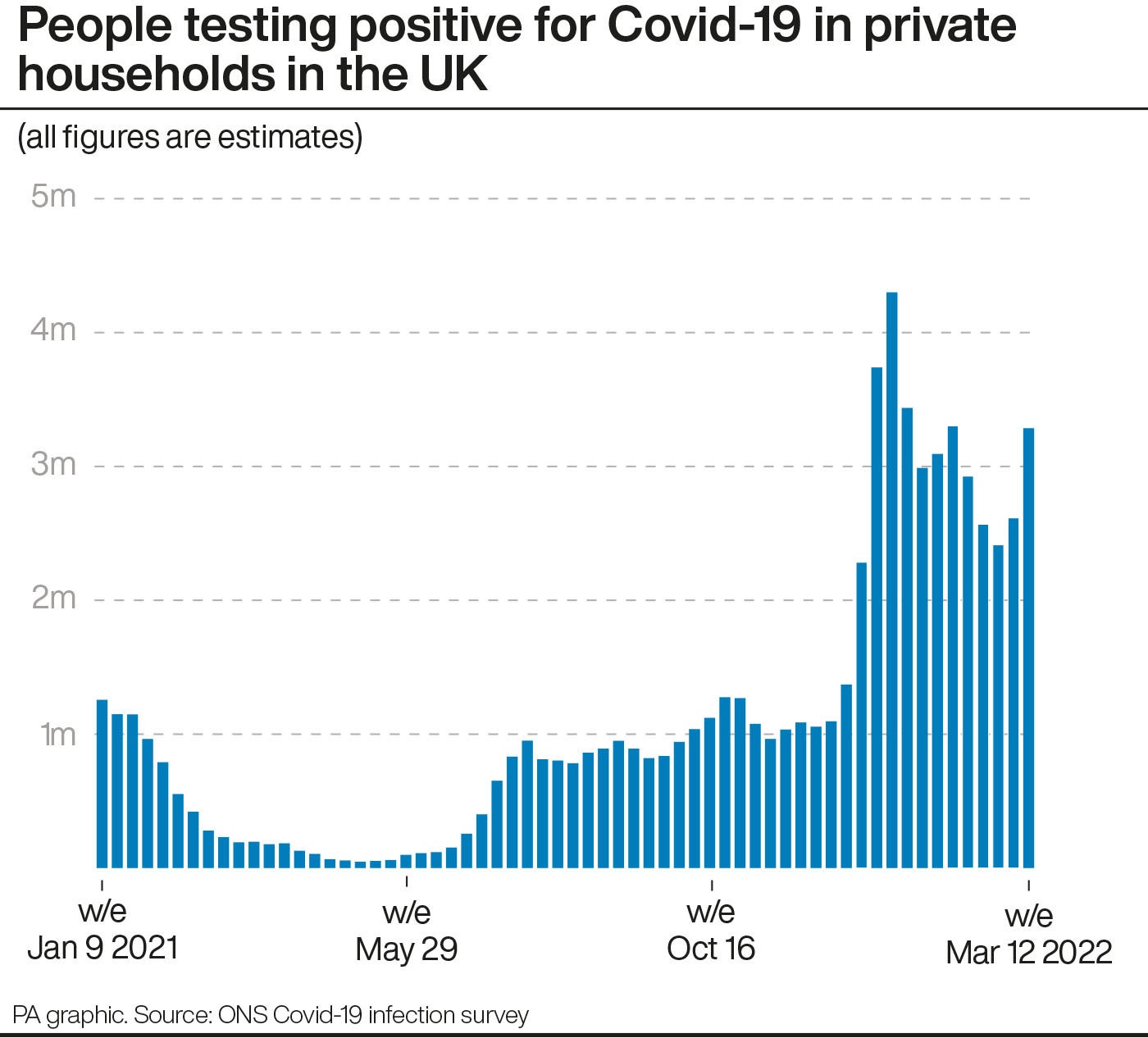
Covid-19 infections are continuing to rise across most of the UK, with levels in Scotland hitting another record high, new figures show.
In England and Wales the virus is now circulating at levels last seen at the start of February, though the trend in Northern Ireland is “uncertain” with infections likely to have fallen slightly.
Across the UK as a whole, 3.3 million people were estimated to have coronavirus last week, up from 2.6 million the previous week, according to the Office for National Statistics (ONS).
This is still some way below levels at the start of the year, when 4.3 million people were likely to have had the virus.
But it is further evidence that Covid-19 is becoming more prevalent across most of the country, and comes as the number of people in hospital with the virus is rising.

Around one in 20 people in private households in England had Covid-19 in the week to March 12, or 2.7 million people, the ONS said.
This is up from one in 25, or 2.1 million people, in the previous week and is the second week in a row that infections are estimated to have increased.
Wales has also seen its second successive jump in infections, with the figure up from 97,900 people, or one in 30, to 125,400, or one in 25.
In Scotland infections have now risen for seven weeks in a row and have reached another record high, with 376,300 people likely to have had Covid-19 last week, or one in 14. This is up from 299,900 people, or one in 18, the previous week.
But in Northern Ireland the ONS described the trend as “uncertain”, with the number down slightly from 143,800 people, or around one in 13, to 130,600, or one in 14.
The ONS infection survey is the most reliable measure of the prevalence of coronavirus in the UK and its latest findings confirm that another increase in infections is under way.
The “rapid rise” of the BA.2 variant – a mutation of the Omicron variant – is driving the high levels of the virus, with BA.2 now accounting for a majority of infections across the country, the ONS said.
The percentage of people testing positive for Covid-19 is estimated to have jumped in all regions of England last week, with the highest prevalence in the south-east (around one in 17 people), London (one in 18) and the south-west (one in 19).
Infections have also risen among all age groups in England, with children from age two to school year 6 estimated to have the highest level (around one in 16), followed by adults aged 25 to 34 (one in 18).
Professor James Naismith, of Oxford University, described the latest figures as a “sharp uptick” in Covid-19, with “quite remarkable” levels in Scotland that reflect the “infectivity of the new strain”.
“At this level of prevalence and the decision not to halt the spread, the most likely outcome is that almost everyone who is susceptible is going to be infected,” he said.
“Without vaccines, this would be bleak. Countries with poor vaccination rates face a very challenging future.
“For the UK, my main concern is for the vulnerable, for whom this disease is serious, and for those whose lives will be blighted by long Covid. Every effort must be made to triple vaccinate as many people as possible, quadruple vaccinate the most vulnerable and make available antivirals,” he added.
The ONS infection survey uses a representative sample of swab tests collected regularly from tens of thousands of households, and is therefore able to estimate the percentage of people likely to test positive for Covid-19 at any one point in time, regardless of when they caught the virus, how many times they have had it and whether they have symptoms.
The survey is far more representative of the level of Covid-19 in the UK than the number of cases announced each day by the Government, which includes only those people who have reported themselves as testing positive for the virus, and is affected by how many people are coming forward for tests or who are taking a test because they know they have coronavirus symptoms.







